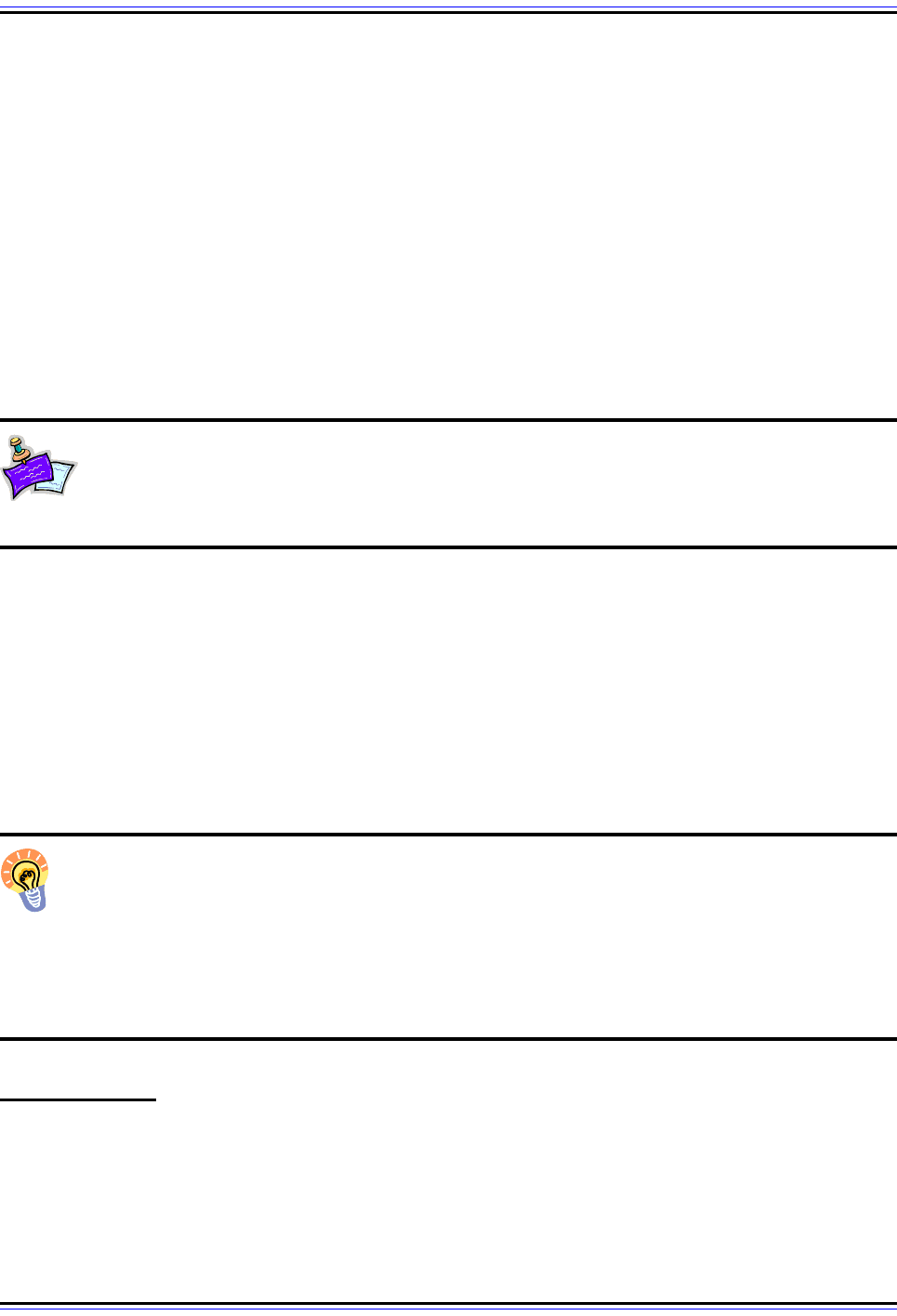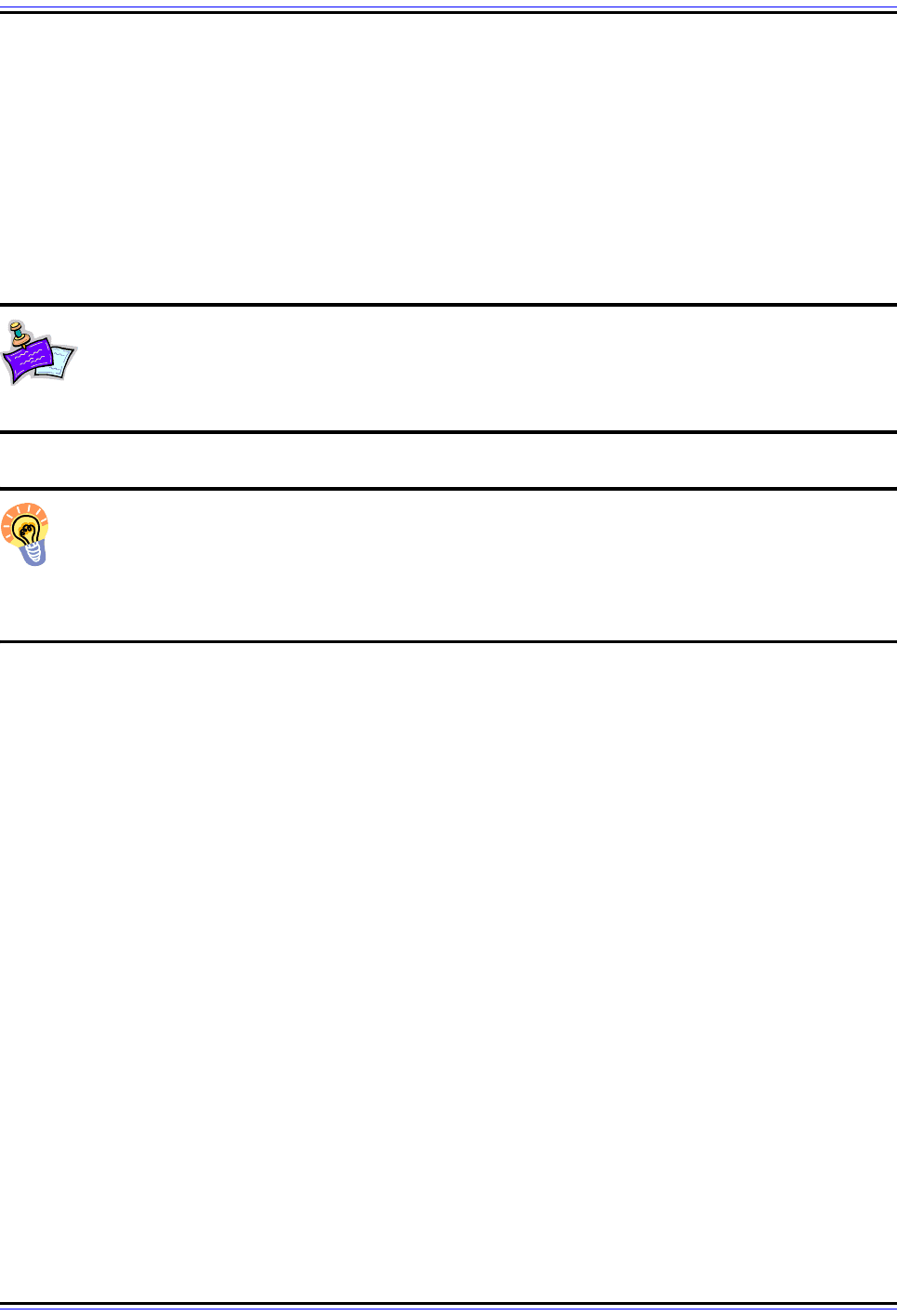Charles M. Kozierok The TCP-IP Guide
Подождите немного. Документ загружается.


The TCP/IP Guide - Version 3.0 (Contents) ` 1551 _ © 2001-2005 Charles M. Kozierok. All Rights Reserved.
Method
The method is simply the type of action that the client wants the server to take; it is always
specified in upper case letters. There are eight standard methods defined in HTTP/1.1, of
which three are widely used: GET, HEAD and POST. They are called “methods” rather than
“commands” because the HTTP standard uses terminology from object-oriented
programming. I explain this and also describe the methods themselves in the topic
describing HTTP methods.
Request URI
The request URI is the uniform resource identifier of the resource to which the request
applies. While URIs can theoretically refer to either uniform resource locators (URLs) or
uniform resource names (URNs), at the present time a URI is almost always an HTTP URL
that follows the standard syntax rules of Web URLs.
Interestingly, the exact form of the URL used in the HTTP request line usually differs from
that used in HTML documents or entered by users. This is because some of the information
in a full URL is used to control HTTP itself. It is needed as part of the communication
between the user and the HTTP client, but not in the request from the client to the server.
The standard method of specifying a resource in a request is to include the path and file
name in the request line (as well as any optional query information) while specifying the
host in the special Host header that must be used in HTTP/1.1 requests.
For example, suppose the user enters a URL such as this:
http://www.myfavoritewebsite.com:8080/chatware/chatroom.php
Figure 317: HTTP Request Message Format
This diagram shows the structural elements of an HTTP request and an example of the sorts of headers a
request might contain. Like most HTTP requests, this one carries no entity, so there are no entity headers and
the message body is empty. See Figure 318 for the HTTP response format.
Message Body
Request Line
General Headers
Request Headers
Entity Headers
GET /index.html HTTP/1.1
Date: Thu, 20 May 2004 21:12:55 GMT
Connection: close
Host: www.myfavoriteamazingsite.com
From: joebloe@somewebsitesomewhere.com
Accept: text/html, text/plain
User-Agent: Mozilla/4.0 (compatible; MSIE 6.0; Windows NT 5.1)
HTTP
Request

The TCP/IP Guide - Version 3.0 (Contents) ` 1552 _ © 2001-2005 Charles M. Kozierok. All Rights Reserved.
We obviously don't need to send the “http:” to the server. The client would take the
remaining information and split it so the URI was specified as “/chatware/chatroom.php”
and the Host line would contain “www.myfavoritewebsite.com:8080”. Thus, the start of the
request would look like this:
GET /chatware/chatroom.php HTTP/1.1
Host: www.myfavoritewebsite.com:8080
The exception to this rule is when a request is being made to a proxy server. In that case,
the request is made using the full URL in its original form, so that it can be processed by the
proxy just as the original client did. The request would be:
GET http://www.myfavoritewebsite.com:8080/chatware/chatroom.php HTTP/1.1
Finally, there is one special case where a single asterisk can be used instead of a real URL.
This is for the OPTIONS method, which does not require the specification of a resource.
(Nominally, the asterisk means the method refers to the server itself.)
HTTP Version
The HTTP-VERSION element tells the server what version the client is using so the server
knows how to interpret the request, and what to send and not to send the client in its
response. For example, a server receiving a request from a client using versions 0.9 or 1.0
will assume that a transitory connection is being used rather than a persistent one, and will
avoid using version 1.1 headers in its reply. The version token is sent in upper case as
“HTTP/0.9”, “HTTP/1.0” or “HTTP/1.1”—just the way I've been doing throughout my
discussion of the protocol.
Headers
After the request line come any of the headers that the client wants to include in the
message; it is in these headers that details are provided to the server about the request.
The headers all use the same structure, but are organized into categories based on the
functions they serve, and whether they are specific to one kind of message or not:
☯ General Headers: General headers refer mainly to the message itself, as opposed to
its contents, and are used to control its processing or provide the recipient with extra
information. They are not particular to either request or response messages, so they
can appear in either. They are likewise not specifically relevant to any entity the
message may be carrying.
☯ Request Headers: These headers convey to the server more details about the nature
of the client's request, and give the client more control over how the request is
handled. For example, special request headers can be used by the client to specify a
conditional request—one that is only filled if certain criteria are met. Others can tell the
server which formats or encodings the client is able to process in a response
message.
☯ Entity Headers: These are headers that describe the entity contained in the body of
the request, if any.

The TCP/IP Guide - Version 3.0 (Contents) ` 1553 _ © 2001-2005 Charles M. Kozierok. All Rights Reserved.
Request headers are obviously used only in request messages, but both general headers
and entity headers can appear in either a request or a response message. Since there are
so many headers and most are not particular to one message type, they are described in
detail in their own complete section.
Key Concept: HTTP requests are the means by which HTTP clients ask servers to
take a particular type of action, such as sending a file or processing user input. Each
request message begins with a request line, which contains three critical pieces of
information: the method (type of action) the client is requesting; the URI of the resource
upon which the client wishes the action to be performed, and the version of HTTP that the
client is using. After the request line come a set of message headers related to the request,
followed by a blank line and then optionally, the message body of the request.
HTTP Response Message Format
Up and down; east and west; black and white; yin and yang. Well, you get the idea. Each
request message sent by an HTTP client to a server prompts the server to send back a
response message. Actually, in certain cases the server may in fact send two responses, a
preliminary response followed by the real one. Usually though, one request yields one
response, which indicates the results of the server's processing of the request, and often
also carries an entity (file or resource) in the message body.
Like requests, responses use their own specific message format that is based on the HTTP
generic message format. The format, shown in Figure 318, is:
<status-line>
<general-headers>
<response-headers>
<entity-headers>
<empty-line>
[<message-body>]
[<message-trailers>]
Status Line
The status line—not “response line”, note—is the start line used for response messages. It
has two functions: to tell the client what version of the protocol the server is using, and to
communicate a summary of the results of processing the client's request. The formal syntax
for the status line is:
<HTTP-VERSION> <status-code> <reason-phrase>

The TCP/IP Guide - Version 3.0 (Contents) ` 1554 _ © 2001-2005 Charles M. Kozierok. All Rights Reserved.
HTTP Version
The HTTP-VERSION label in the status line serves the same purpose as it does in the
request line of a request message; here, it tells the client the version number that the server
is using for its response. It uses the same format as in the request line, in upper case as
“HTTP/0.9”, “HTTP/1.0” or “HTTP/1.1”. The server is required to return an HTTP version
number that is no greater than that the client sent in its request.
Status Code and Reason Phrase
The status code and reason phrase provide information about the results of processing the
client's request in two different forms. The status code is a three-digit number that indicates
the formal result that the server is communicating to the client; it is intended for the client
HTTP implementation to process so the software can take appropriate action. The reason
phrase is an additional, descriptive text string, which can be displayed to the human user of
the HTTP client so he or she can see how the server responded. I describe status codes
and reason phrases later in this section, and also list all of the standard codes.
Headers
The response message will always include a number of headers that provide extra infor-
mation about it. Response message headers fall into these categories:
Figure 318: HTTP Response Message Format
This figure illustrates the construction of an HTTP response, and includes an example of both message
headers and body. The status code “200” indicates that this is a successful response to a request; it contains
a brief text HTML entity in the message body. See Figure 317 for the HTTP request format.
Message Body
Status Line
General Headers
Entity Headers
HTTP/1.1 200 OK
Date: Thu, 20 May 2004 21:12:58 GMT
Connection: close
HTTP
Response
<html>
<head>
<title>Welcome to the Amazing Site!</title>
</head>
<body>
<p>This site is under construction. Please come
back later. Sorry!</p>
</body>
</html>
Content-Type: text/html
Content-Length: 170
Last-Modified: Tue, 18 May 2004 10:14:49 GMT
Response Headers
Server: Apache/1.3.27
Accept-Ranges: bytes

The TCP/IP Guide - Version 3.0 (Contents) ` 1555 _ © 2001-2005 Charles M. Kozierok. All Rights Reserved.
☯ General Headers: General headers that refer to the message itself and are not
specific to response messages or the entity in the message body. These are the same
as the generic headers that can appear in request messages (though certain headers
appear more often in responses and others are more common in requests).
☯ Response Headers: These headers provide additional data that expands upon the
summary result information in the status line. The server may also return extra result
information in the body of the message, especially when an error occurs, as discussed
below.
☯ Entity Headers: These are headers that describe the entity contained in the body of
the response, if any. These are the same entity headers that can appear in a request
message, but they are seen more often in response messages. The reason for this is
simply that responses more often carry an entity than requests, because most
requests are to retrieve a resource.
Note: Entity headers may appear in a response to describe the resource that is
the subject of the request, even if the entity itself is not sent in the message. This
occurs when the HEAD method is used to request only the headers associated
with an entity.
Response headers are of course used only in response messages, while the others are
general with respect to message type. See the section describing HTTP headers for more
details.
Most response messages contain an entity in the message body. In the case of a
successful request to retrieve a resource, this is the resource itself. Responses indicating
unsuccessful requests usually contain detailed error information, often in the form of an
HTML-formatted error message.
Key Concept: Each HTTP request sent by a client leads to a server returning one or
more HTTP responses. Each response message starts with a status line that
contains the server’s HTTP version number, and a numeric status code and text
reason phrase that indicate the result of processing the client’s request. The message then
contains headers related to the response, followed by a blank line and then the optional
message body. Since most HTTP requests ask for a server to return a file or other resource,
many HTTP responses carry an entity in the message body.
HTTP Methods
A request sent by a client to a server obviously… requests that the server do something. All
client/server protocols provide a way for the client to prompt the server to take action,
generally by having the client give the server a series of commands. HTTP, in contrast,
does not have commands but rather methods. Each client request message begins with the
specification of the method that is the subject of the request.

The TCP/IP Guide - Version 3.0 (Contents) ` 1556 _ © 2001-2005 Charles M. Kozierok. All Rights Reserved.
What is the difference between a method and a command? In practical terms, nothing; they
are the same. So why does HTTP use the term “method” instead of “command”? Good
question. ☺ The answer can be found in the abstract of the standard defining HTTP/1.0,
RFC 1945. It states, in part, that HTTP is:
“a generic, stateless, object-oriented protocol which can be used for
many tasks…”
In highly simplified terms, object-oriented programming is a technique in which software
modules are described not as sets of procedures but as objects that possess attributes.
These modules send messages to each other to communicate, and to cause actions to be
performed, where the action taken depends on the nature of the object. In object-oriented
programming, the procedures each object can perform are called methods.
HTTP is considered to be object-oriented because in many cases, the action taken by a
server depends on the object that is the subject of the request. For example, if you ask a
server to retrieve a text document, it will send that document, but if you ask for a directory,
the server may instead return a default document for that directory. In contrast, a request
that specifies the name of a program will result in the program being executed and its
output returned (as opposed to the program’s source code being returned.)
Common Methods
Each method allows the client to specify a particular type of action to be taken by the server.
Method names are always in upper case letters. There are three methods that are
commonly used in HTTP.
GET
The GET method requests that server retrieve the resource specified by the URL on the
HTTP request line and send it in a response back to the client. This is the most basic type of
request and the one that accounts for the majority of HTTP traffic. When you enter a
conventional URL or click on a link to a document or other file, you are usually prompting
your Web browser to send a GET request.
The handling of a GET request depends on a number of factors. If the URL is correct and
the server can find the resource, it will of course send back the appropriate response to the
client. As mentioned above, the exact resource returned depends on the nature of the
object requested. If the request cannot be processed properly, an error message may
result. Caching also comes into play, as a proxy server or even the client itself might satisfy
the request before it gets to the server.
It’s important to remember that the meaning of a GET request may change if certain
headers, such as If-Modified-Since or If-Match are used—these and other similar headers
tell the server to only send the resource if certain conditions are met. A request of this sort
is sometimes called a conditional GET. Similarly, the Range header may be used by the
client to request that the server send it only part of a resource; this is usually used for large
files. When this header is included, the request may be called a partial GET.

The TCP/IP Guide - Version 3.0 (Contents) ` 1557 _ © 2001-2005 Charles M. Kozierok. All Rights Reserved.
HEAD
This is identical to the GET method, but tells the server to not send the actual body of the
message. Thus, the response will contain all of the headers that would have accompanied a
reply to the equivalent GET message, including entity headers describing the entity that the
server would have sent had the method been GET. This method is often used by the client
to check the existence, status or size of a file before deciding whether or not it wants the
server to send the whole thing.
HEAD requests are processed in the same way as GET requests, except that only the
headers are returned, not the actual resource.
POST
This method allows the client to send an entity containing arbitrary data to the server for
processing. It is commonly used to enable a client to submit information such as an inter-
active HTML form to a program on the server, which then takes action based on that input
and sends a response. This capability is now used for all sorts of online programs. The URL
in the request specifies the name of the program on the server that is to accept the data.
Contrast this with the PUT method below.
Other, Less-Common Methods
The other methods defined by the HTTP standard are not used as often, but I will describe
them briefly, as you may still encounter them from time to time.
OPTIONS
Allows the client to request that the server send it information about available communi-
cation options. A URI of a resource may be specified to request information relevant to
accessing that resource, or an asterisk (“*”) may be used to indicate that the query is about
the server itself. The response includes headers that give the client more details about how
the server may be accessed.
PUT
Requests that the server store the entity enclosed in the body of the request at the URL
specified in the request line. The difference between a PUT and a POST is that in a PUT,
the URI identifies the entity in the request, while in a POST, the URI identifies a program
intended to process the entity in the request. Thus a PUT would be used to allow a file to
be copied to a server, in the exact complement to how a GET requests that a file be copied
to the client. A POST is used for interactive programs, as explained above.
Now, would you like people to be able to store files on your server in the same way that they
request them? Neither would I. This is one primary reason why PUT is not often used. It has
valid uses, such as uploading content to a Web site, and must be used with authentication
in this case. However, generally speaking, storing files on a site is more often accomplished
using other means, like FTP.

The TCP/IP Guide - Version 3.0 (Contents) ` 1558 _ © 2001-2005 Charles M. Kozierok. All Rights Reserved.
DELETE
Requests that the specified resource be deleted. This has the same issues as PUT and is
not often used for similar reasons.
TRACE
Allows a client to receive back a copy of the request that it itself sent to the server, for
diagnostic purposes.
Note: In addition to the methods described above, the HTTP standard reserves
the method name CONNECT for future use. An earlier version of HTTP/1.1, RFC
2068, also defined the methods PATCH, LINK and UNLINK. These were removed
in the final version but reference to them is still sometimes seen.
Key Concept: Each HTTP client request specifies a particular type of action that the
server perform; in HTTP, these are called not commands but rather methods. The
three most common HTTP methods are GET, which prompts a server to return a
resource; HEAD, which returns just the headers associated with a resource; and PUT,
which allows a client to submit data to a server for processing.
"Safe" and Idempotent Method Categorizations
As we've seen above, methods vary greatly in the type of behavior they cause the server to
take. The HTTP standard defines two characteristics that can be used to differentiate
methods based on the impact they have on a server:
☯ “Safe” Methods: These are methods that an administrator of a server can feel
reasonably comfortable permitting a client to send because they are very unlikely to
have any negative “side-effects”. The methods usually put into this category are GET,
HEAD, OPTIONS and TRACE. The methods that cause data to be accepted by the
server for processing, or lead to changes on the server, are deemed “unsafe”: POST,
PUT, and DELETE. (The fact that they are “unsafe” doesn't mean a server never
allows them, just that they require more care and detail in handling than the others.)
☯ Idempotent Methods: Woah, 10-dollar word time. ☺ A method is said to be
idempotent if repeating the same method request numerous times causes the exact
same results as if the method were issued only once. For example, if you load a Web
page in your browser, and then type the same URL in again, you get the same result,
at least most of the time. In general, all of the methods in HTTP have this property
inherently except one: POST.

The TCP/IP Guide - Version 3.0 (Contents) ` 1559 _ © 2001-2005 Charles M. Kozierok. All Rights Reserved.
The POST method is not idempotent because each instance of a POST request causes the
receiving server to process the data in the request's body. Submitting a POST request two
or more times can often lead to undesirable results. The classic example is hitting the
“submit” button on a form more than once, which can lead to annoyances such as a
duplicate message on an Internet forum, or even a double order at an online store.
There are also situations where a method that is normally idempotent may not be. A GET
request for a simple document is idempotent, but a GET for a script can change files on the
server and therefore is not idempotent. Similarly, a sequence of idempotent methods can
be non-idempotent. For example, consider a situation where a PUT request is followed by a
GET for the same resource. This sequence is non-idempotent because the second request
depends on the results of the first.
The significance of non-idempotence is that clients must handle such requests or
sequences specially. The client must keep track of them, and make sure that they are filled
in order and only once. The HTTP standard also specifies that non-idempotent methods
should not be pipelined, to avoid problems if an HTTP session is unexpectedly terminated.
For example, if two POST requests were pipelined and the server got hung up handling
them, the client would need to reissue them but might not know how many of the originals
had been successfully processed.
HTTP Status Code Format, Status Codes and Reason Phrases
Every request sent by an HTTP client causes one (or more) responses to be returned by
the server that receives it. As we saw in the topic describing the response message format,
the first line of the response is a status line that contains a summary of the results of
processing the request. The purpose of this line is to communicate quickly whether or not
the request was successful, and why.
HTTP status lines contain both a numeric status code and a text reason phrase. The idea
behind this was taken directly from earlier application layer protocols such as FTP, SMTP
and NNTP. The reason for having both a number and a text string is that computers can
more easily “understand” the results of a request by looking at a number, and can then
quickly respond accordingly. Humans, on the other hand, find numbers cryptic and text
descriptions easier to comprehend. (The topic on FTP reply codes discusses more
completely the reasons why numeric reply codes are used in addition to descriptive text.)

The TCP/IP Guide - Version 3.0 (Contents) ` 1560 _ © 2001-2005 Charles M. Kozierok. All Rights Reserved.
Status Code Format
HTTP status codes are three digits in length and follow a particular format where the first
digit has particular significance. Unlike FTP and the others, the second digit does not stand
for a functional grouping; the second and third digits together just make 100 different
options for each of the categories indicated by the first digit. Thus, the general form of an
HTTP status code is “xyy”, where the first digit, “x”, is specified as given in Table 275.
In each of these five groups, the code where “yy” is “00” is defined as a “generic” status
code for that group, while other two-digit combinations are more specific responses. For
example, “404” is the well-known specific error message that means the requested
resource was not found by the server, while “400” is the less specific “bad request” error.
This system was set up to allow the definition of new status codes that certain clients might
not comprehend. If a client receives a strange code, it just treats it as the equivalent of the
generic response in the appropriate category. So if a server response starts with the code
“491” and the client has no idea what this is, it just treats it as a 400 “bad request” reply.
Reason Phrases
The reason phrase is a text string that provides a more meaningful description of the error
for people who are bad at remembering what cryptic codes stand for (which would be most
of us!) The HTTP standard includes “sample” reason phrases for each status code, but
these can be customized by the administrators of a server if desired. When a server returns
a more detailed HTML error message in the body of its response message, the reason
phrase is often used for the “title” tag in that message body.
Table 275: HTTP Status Code Format: First Digit Interpretation
Status
Code
Format
Meaning Description
1yy
Informational
Message
Provides general information; does not indicate success or failure of a
request.
2yy Success The method was received, understood and accepted by the server.
3yy Redirection
The request did not fail outright, but additional action is needed before it
can be successfully completed.
4yy Client Error
The request was invalid, contained bad syntax or could not be
completed for some other reason that the server believes was the
client's fault.
5yy Server Error
The request was valid but the server was unable to complete it due to a
problem of its own.
